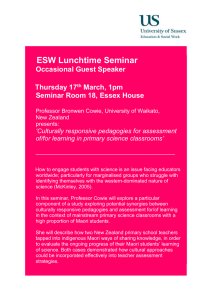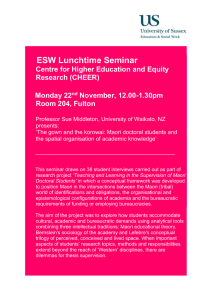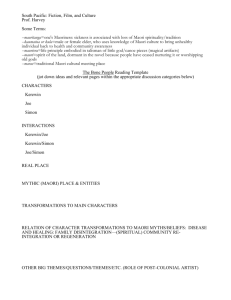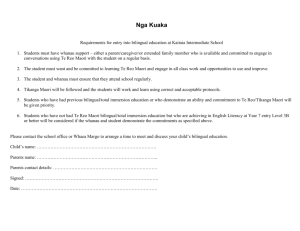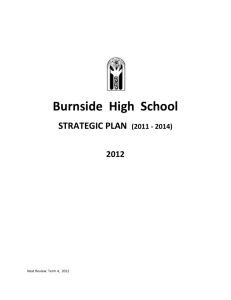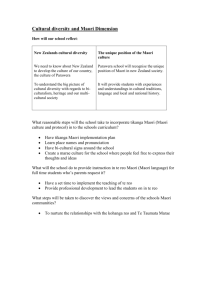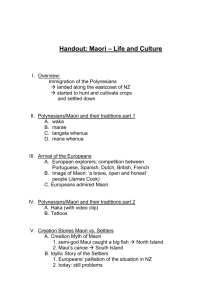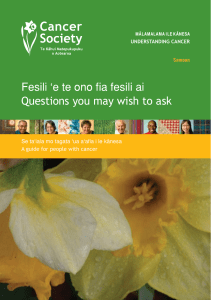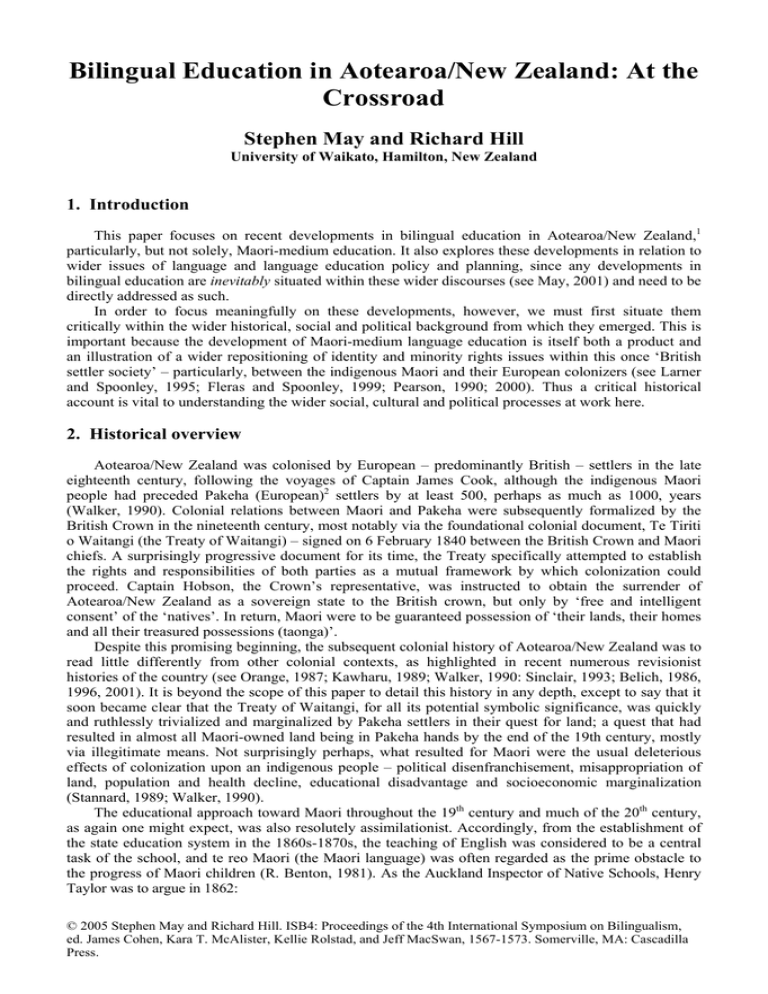
Bilingual Education in Aotearoa/New Zealand: At the
Crossroad
Stephen May and Richard Hill
University of Waikato, Hamilton, New Zealand
1. Introduction
This paper focuses on recent developments in bilingual education in Aotearoa/New Zealand,1
particularly, but not solely, Maori-medium education. It also explores these developments in relation to
wider issues of language and language education policy and planning, since any developments in
bilingual education are inevitably situated within these wider discourses (see May, 2001) and need to be
directly addressed as such.
In order to focus meaningfully on these developments, however, we must first situate them
critically within the wider historical, social and political background from which they emerged. This is
important because the development of Maori-medium language education is itself both a product and
an illustration of a wider repositioning of identity and minority rights issues within this once ‘British
settler society’ – particularly, between the indigenous Maori and their European colonizers (see Larner
and Spoonley, 1995; Fleras and Spoonley, 1999; Pearson, 1990; 2000). Thus a critical historical
account is vital to understanding the wider social, cultural and political processes at work here.
2. Historical overview
Aotearoa/New Zealand was colonised by European – predominantly British – settlers in the late
eighteenth century, following the voyages of Captain James Cook, although the indigenous Maori
people had preceded Pakeha (European)2 settlers by at least 500, perhaps as much as 1000, years
(Walker, 1990). Colonial relations between Maori and Pakeha were subsequently formalized by the
British Crown in the nineteenth century, most notably via the foundational colonial document, Te Tiriti
o Waitangi (the Treaty of Waitangi) – signed on 6 February 1840 between the British Crown and Maori
chiefs. A surprisingly progressive document for its time, the Treaty specifically attempted to establish
the rights and responsibilities of both parties as a mutual framework by which colonization could
proceed. Captain Hobson, the Crown’s representative, was instructed to obtain the surrender of
Aotearoa/New Zealand as a sovereign state to the British crown, but only by ‘free and intelligent
consent’ of the ‘natives’. In return, Maori were to be guaranteed possession of ‘their lands, their homes
and all their treasured possessions (taonga)’.
Despite this promising beginning, the subsequent colonial history of Aotearoa/New Zealand was to
read little differently from other colonial contexts, as highlighted in recent numerous revisionist
histories of the country (see Orange, 1987; Kawharu, 1989; Walker, 1990: Sinclair, 1993; Belich, 1986,
1996, 2001). It is beyond the scope of this paper to detail this history in any depth, except to say that it
soon became clear that the Treaty of Waitangi, for all its potential symbolic significance, was quickly
and ruthlessly trivialized and marginalized by Pakeha settlers in their quest for land; a quest that had
resulted in almost all Maori-owned land being in Pakeha hands by the end of the 19th century, mostly
via illegitimate means. Not surprisingly perhaps, what resulted for Maori were the usual deleterious
effects of colonization upon an indigenous people – political disenfranchisement, misappropriation of
land, population and health decline, educational disadvantage and socioeconomic marginalization
(Stannard, 1989; Walker, 1990).
The educational approach toward Maori throughout the 19th century and much of the 20th century,
as again one might expect, was also resolutely assimilationist. Accordingly, from the establishment of
the state education system in the 1860s-1870s, the teaching of English was considered to be a central
task of the school, and te reo Maori (the Maori language) was often regarded as the prime obstacle to
the progress of Maori children (R. Benton, 1981). As the Auckland Inspector of Native Schools, Henry
Taylor was to argue in 1862:
© 2005 Stephen May and Richard Hill. ISB4: Proceedings of the 4th International Symposium on Bilingualism,
ed. James Cohen, Kara T. McAlister, Kellie Rolstad, and Jeff MacSwan, 1567-1573. Somerville, MA: Cascadilla
Press.
The Native language itself is also another obstacle in the way of civilisation, so long as it exists there
is a barrier to the free and unrestrained intercourse which ought to exist between the two races [sic], it
shuts out the less civilised portion of the population from the benefits which intercourse with the
more enlightened would confer. The school-room alone has power to break down this wall of
partition... (AJHR, E-4, 1862, 35-38)
The inevitable result was the marginalization of Maori, and te reo Maori, within the educational
process,3 and over the course of the 20th century, its subsequent decline. The rapid urbanization of
Maori since the Second World War4 has been a key contributory factor to this language decline. While
the Maori language had long-been excluded from the realms of the school, it had still been nurtured in
largely rural Maori communities. Urbanization was to change all that. Thus, in 1930, a survey of
children attending Native schools estimated that 96.6 per cent spoke only Maori at home. By 1960, only
26 per cent spoke Maori. By 1979 the Maori language had retreated to the point where language death
was predicted (R. Benton, 1979, 1983; see also N. Benton, 1989).
Despite significant developments since that time – notably the re-emergence of Maori-medium
education (see below) – more recent statistics suggest that the Maori language is still endangered. In
1995, a general language survey found that nine out of ten of Aotearoa/New Zealand’s then 3.8 million
inhabitants were first language speakers of English – a figure that made it one of the most linguistically
homogeneous countries in the world (Te Taura Whiri i te Reo Maori, 1995). Meanwhile, the most
recent survey of the Maori language (Te Puni Kokiri, 2001) found that among Maori adults, only 20%
(approx. 68,000) spoke the language well, or very well, and that the majority of these were middle-aged
or older. More worryingly, 58% of Maori adults could not speak Maori beyond a ‘few words or
phrases’.
It is this background of rapid and significant language loss for Maori that has precipitated the rise
of bilingual education in Aotearoa/New Zealand.5 The first development in bilingual education
occurred in the late 1970s with the establishment of transitional bilingual education programs in a few
schools that still served predominantly rural Maori communities. Other schools were to follow –
providing, primarily, a ‘transition’ approach to bilingualism. However, it was the establishment in the
1980s of maintenance bilingual, whole-school Maori language programs, which were also
predominantly full-immersion, that has been the most significant development in Aotearoa/New
Zealand, and the one that has gained most international attention. This began with the establishment in
1982 of Te Kohanga Reo – full immersion preschool programs, initially run independently by parents.
It has since developed to all levels of education and has subsequently been incorporated into the state
education system, thus spearheading the beginnings of what Christina Paulston has described as
‘language reversal’; a process by which ‘one of the languages of a state begins to move back into more
prominent use’ (1993: 281).
To gauge the significance and impact of these developments, one only has to look at the growth of
this Maori language education movement. In 1982, the first Kohanga Reo was established – by 1996, at
its high point, there were 767 kohanga catering for over 14,000 Maori children (New Zealand Ministry
of Education, 1998). Although there has been some decline in numbers since then, there were still
9,500 Maori students (approx. 30% of all Maori preschool enrolments) enrolled in 560 Kohanga in
2001.
This expansion has also had a ‘domino effect’ throughout the education system, as kohanga
graduates have worked their way through the school system over the course of the last twenty years.
This is particularly evident at the primary (elementary) level with the emergence of the first (privately
funded) Kura Kaupapa Maori (literally, Maori philosophy school) in 1985 – based on the same
principles of maintenance bilingual education and full-immersion. In 1990, 6 Kura Kaupapa Maori
were approved for state funding and by 1999, 59 Kura Kaupapa Maori had been established, serving
approximately 4,000 students (New Zealand Ministry of Education, 1998). These developments are
also now beginning to extend to higher educational levels with the establishment in 1993/1994 of the
first Wharekura (Maori-medium secondary schools) and Whare Wananga (tertiary institutions). By
1997 there were four such Wharekura and three Wananga.
In addition to these developments in full-immersion bilingual education, and perhaps also as a
direct result of their influence, there has been a related expansion of targeted, partial-immersion models
of bilingual education in ‘mainstream’ Aotearoa/New Zealand schools, again predominantly for Maori
students. As a result, in 2001, there were 25,580 Maori students enrolled in some form of Maori-
• 1568 •
medium education, comprising 17% of the total Maori student population. Of these, the vast majority
(22,349; 87%) were enrolled in primary (elementary) programs (Te Puni Kokiri, 2001).6
3. Current issues
These specific developments in bilingual education have also been situated within a wider
reappraisal of language policy, itself the result of the re-emergence of the Treaty of Waitangi into
public life and policy-making in the 1980s (for further discussion of these wider developments, see
May, 2002a). This led in turn in 1987 to the implementation of the Maori Language Act, which
accorded Maori for the first time since colonization with official language status within Aotearoa/New
Zealand. Indeed, this stands as one of the only examples currently in the world where the first language
of an indigenous people has been recognized as a state language (May, 2001).7 The related exponential
rise, and success of Maori language immersion programs at all levels of education is clearly situated
within this wider context.
But there are also significant limits to these developments. The Language Act does not extend the
right to use or to demand the use of Maori in the public domain beyond the oral use of the language in
Courts of law and some quasi-legal Tribunals. Likewise, the use of Maori remains limited in most
household and community contexts. Most worryingly, the 2001 Maori language survey found that there
were generally few conversations conducted in the home in Maori. In the community, Maori language
was highest (not surprisingly perhaps) in those contexts where Maori people were predominant –
people spoke Maori for half or more of the time at marae (meeting houses) – 50% (of people), Maori
hui (meetings) – 42%, and church-related activities – 32%. Very few people spoke Maori for half or
more of the time in the workplace (14%), at sport (10%), shopping (5%), or socializing (11%) (Te Puni
Kokiri, 2001).
This suggests strongly that a diglossic situation for Maori (as the more delimited, domaindependent language in relation to English) still clearly applies in the Aotearoa/New Zealand context,
despite the advances in Maori-medium education over the last 20 years. This is further confirmed when
one realizes that, while the rise of Maori language medium education has been spectacular, it still
constitutes only a small percentage of the overall state provision of education in Aotearoa/New
Zealand, even to Maori students, let alone all.8
There are also, increasingly, specific issues emerging within Maori-medium education itself –
particularly with respect to:
• level of immersion and whole-school/targeted programs
• student population / balance of L1/L2 learners
3.1 Level of immersion
In the Kohanga/Kura model, a full-immersion approach to Maori is almost always adopted. This
emerged out of a commitment to maintenance bilingual education and an awareness of the
precariousness of the wider language context for Maori. In addition, the transitional bilingual programs
that were initially developed in the 1970s, as with most transitional programs, were soon found to be
relatively ineffective in promoting ongoing Maori language maintenance.
However, what seems to have transpired is that full-immersion has actually come to be elided with
maintenance bilingualism in the thinking of many advocates of Maori-medium education. Or to put it
another way, all partial-immersion bilingual programs, including the burgeoning number in mainstream
school contexts, have tended to be viewed simply as subtractive and/or transitional programs.
This clearly runs counter to the international literature on bilingual education, particularly with
respect to the success of dual-medium/two way bilingual programs in the USA. It also leaves the
partial-immersion programs in mainstream Aotearoa/New Zealand schools with little access to positive
models of maintenance bilingualism and to research-based indicators of good practice in these contexts.
Indeed, such mainstream bilingual education programs have tended to be rather ad hoc in terms of
their educational approach, with little consistency, or underlying theory, to their pedagogy and practice.
This is compounded by a funding formula for schools in Aotearoa/New Zealand that recognizes 4
levels of immersion: Level 1 (81-100%); Level 2 (51-80%); Level 3 (31-50%); Level 4 (12-30%).
While the clear majority of the 25,580 students in Maori-medium education are in Levels 1 (11, 064)
• 1569 •
and 2 (5,073) – 16,137 – it is equally clear that Levels 3 and 4 do not reach the minimum threshold
criterion of 50% instruction in the target language which is regarded as a necessary condition for
effective bilingual education in the research literature.
Relatedly, there is little discussion in Aotearoa/New Zealand, at least as yet, as to how to make targeted
programs in mainstream contexts (as opposed to the whole-school model adopted by Kohanga and
Kura Kaupapa programs) work effectively. Again, the research literature available is quite clear in
identifying key criteria here, including issues of educational leadership, school organization and more
specific issues of instructional design. However, this research has not been widely drawn upon, given
the generally negative view of such programs up until now.
3.2 Student population
More generally, there is a still largely unresolved issue about the influence of L1/L2 characteristics
in Maori-medium education.
Given the generational language loss of the Maori language that we described earlier – particularly
post-WW2 – the majority of students in Maori-medium education, and indeed many of the teachers, are
actually second language learners. In this sense, while full-immersion Maori-medium education is
specifically underpinned by the principles of a maintenance bilingual education approach, its student
population is closer to an enrichment bilingual education context. The complex interplay between these
maintenance bilingual principles (which usually apply to L1 speakers) and the predominantly L2
language context, is one that has yet to be fully addressed, although this is also an ongoing issue for
many other indigenous and/or heritage language education programs where generational loss of the
language has already occurred.
3.3 Other language groups
Returning to the wider language context, there is the ongoing question of the provision of bilingual
education (or rather, the lack thereof) for other language groups in Aotearoa/New Zealand. These
groups comprise most obviously Pasifika peoples, many of whom are now 2nd or 3rd generation and
New Zealand-born, having first settled in Aotearoa/New Zealand in the 1960s. There has also been a
significant growth of South East Asian economic migrants to Aotearoa/New Zealand over the course of
the 1990s – bolstering long-standing, but previously very small Asian groups – along with the increased
presence of refugee groups, initially from Vietnam and Cambodia and more recently from Somalia.
At present, the language and education provision for such groups remains very limited, the result
largely of the predominance of English in Aotearoa/New Zealand and, the re-emergence of Maori
aside, the ongoing valorization of English as both the pre-eminent national and international language.
Consequently, an assimilationist imperative and a subtractive view of bilingualism are still clearly
apparent in the majority of language policies, and language education policies, aimed at ethnic minority
groups (New Zealand Ministry of Education, 1994; R. Benton, 1996: May, 2002b).
These ongoing negative attitudes towards bilingualism and bilingual education for these groups can
be seen, for example, in the deliberate delay in recent years in providing Pasifika students with any
meaningful access to bilingual education. This, despite the fact that many remain first language
speakers of Pasifika languages, and despite a recent assurance by the New Zealand Ministry of
Education that ‘students whose mother tongue is a Pacific Islands language or a community language
will have the opportunity to develop and use their own language as an integral part of their schooling’
(1993: 10). That said, Maori-medium education does appear to have provided a template for the nascent
emergence of comparable Pasifika preschool language nests, modelled on Te Kohanga Reo,9 and, more
recently, a limited number of primary (elementary) programmes. Meanwhile, a draft Pasifika bilingual
education policy has finally been developed and is currently before the Minister of Education although
whether any positive outcome will ensue is uncertain.
• 1570 •
3.4 Resourcing and support
Finally, there is the ongoing issue – faced by Maori-medium education, and even more so by other
language groups – of adequate resourcing and support. While there has been a rapid expansion of
Maori/English bilingual training programmes within teacher education in recent years, there is an
ongoing dearth of applicants with sufficient Maori language skills for such programs. Thus, these
programs often end up spending much of their time on improving the participants Maori language
skills, with insufficient attention paid to key issues such as instruction in second language teaching
methodologies.
Likewise, there is a growing expansion of Maori language teaching material, and assessment
practices, particularly at the elementary school level, but there is still much to be done here as well,
particularly in establishing empirically-sound Maori language benchmarks for the predominantly
second language learners of Maori in these programs.10
4. Conclusion
To conclude, it has not been our intention to present here an overly negative picture of bilingual
education in Aotearoa/New Zealand. Rather, we have wanted to highlight that, even when there have
been significant advances made in bilingual education, as is clearly the case in Aotearoa/New Zealand,
there remain ongoing and equally significant challenges. Moreover, these challenges are not just
educational – indeed they never are just educational – but are invariably framed within the wider
language, social and political context.
In this respect, it should not be forgotten that the stakes are enormously high – in Aotearoa/New
Zealand’s case, the possibility of moving from a predominantly monolingual, colonising context to a
genuinely bilingual and bicultural country, founded on the principles of the Treaty of Waitangi, and
which is genuinely open to other language groups as well. This possibility still seems some way off –
perhaps it will never be achievable, given the level of Maori language loss that has already resulted and
the wider, ongoing dominance of English. However, the fact that it remains even a possibility, no
matter how remote, is in no small part due to the significant advances in bilingual education outlined
above.
Education may well not be able to compensate for society, or for wider language shift and loss, but
it can still make a significant, even crucial, difference. In this respect, we are reminded of James
Tollefson’s observation, over ten years ago now, that:
the struggle to adopt minority languages within dominant institutions such as education … as
well as the struggle over language rights, constitute efforts to legitimise the minority group
itself and to alter its relationship to the state. Thus while language [education] planning
reflects relationships of power, it can also be used to transform them. (1991: 202; see also
1995)
• 1571 •
Notes
1
Aotearoa (land of the long white cloud) is the indigenous Maori name for the country now
known as New Zealand. Maori first settled in New Zealand towards the end of the Pacific
migrations which occurred from the second to the eighth centuries AD (Walker, 1990). The
term New Zealand itself derives from the Dutch origins of the ‘first’ European explorer to
sight the country in the seventeenth century. The conjoint use of the two names is becoming
increasingly common and specifically recognizes the bicultural origins of the country.
2
‘Pakeha’ is the Maori term for New Zealanders of European origin. Its literal meaning is
‘stranger’, although it holds no pejorative connotation in modern usage.
3
This was not always so. The early mission schools which, while they taught only the
standard subjects of the English school curriculum, did so through the medium of Maori. As a
result, the period in which these schools were most influential – 1816 to the mid 1840s – saw
a rapid spread of literacy among Maori in both Maori and English.
4
Prior to the Second World War less than 10 per cent of Maori had lived in cities or smaller
urban centres. Currently, 82 per cent of Maori live in urban areas (Te Taura Whiri i te Reo
Maori, 1995). Maori have thus undergone what is perhaps the most comprehensive and
certainly the most rapid urbanization process in modern times.
5
This is, in turn, the product of a broader realignment of Maori/Pakeha relations since the
1980s which has seen the re-emergence of the Treaty of Waitangi as a central document in
shaping Aotearoa/New Zealand public policy, including language education (May, 2002a; see
also below).
6
Provision for Maori-medium education at the secondary and tertiary level remains very
limited, due to the very small number of Maori-medium providers here. Most students at
secondary level take Maori as a subject (In 2001, 33,203 took Maori as a subject for less that
3 hours a week; 8,075 for more than 3 hours a week), with the usual limitations that such a
subject-based approach entails (lack of interest, lack of communicative fluency etc). In 2001,
there were 1693 Maori language EFTS (equivalent full time students) at the tertiary level,
58% located in the three whare wananga (Te Puni Kokiri, 2001).
7
The Act also provided for the establishment of a Maori Language Commission, Te Taura
Whiri i te Reo Maori. Closely modeled on the Irish Bord na Gaeilge (see Ó Riagáin, 1997),
the Commission’s role is to monitor and promote the use of the language, although its staff
and resources are limited. A recent Draft National Languages Policy has continued these
positive developments by highlighting, as its top priority, the reversal of the decline in the
Maori language (Waite, 1992), although as yet further action in implementing the Draft report
has not been forthcoming.
8
In 1996, for example, only 2.3 per cent of Maori school students were enrolled in a kura; the
vast majority remain in the mainstream, predominantly monolingual education system (New
Zealand Ministry of Education, 1998).
9
In 1993, 177 such language nests, catering for 3877 children, were receiving government
funding (R. Benton, 1996).
10
A Maori language method of organising reading materials into various levels of reading
difficulty – Nga Kete Korero – was developed in the mid-1990s, although this applies
predominantly to beginning and early readers in junior classes. For students working beyond
the Nga Kete Korero levels, there is currently no empirically based method of identifying
difficulty levels of Maori language texts, although there is work in progress to extend the
framework to include reading material appropriate to middle and senior schools.
• 1572 •
References
AJHR Appendices to the Journals of the House of Representatives 1858-1939. Wellington, New Zealand.
Belich, J. (1986). The New Zealand Wars. Auckland, New Zealand: Auckland University Press.
Belich, J. (1996). Making Peoples. Auckland, New Zealand: Allen Lane.
Belich, J. (2001). Paradise Reforged. Auckland, New Zealand: Allen Lane.
Benton, N. (1989). Education, language decline and language revitalisation: the case of Maori in New Zealand.
Language and Education 3, 65-82.
Benton, R. (1979). Who Speaks Maori in New Zealand. Wellington, New Zealand: New Zealand Council for
Educational Research.
Benton, R. (1981). The Flight of the Amokura: Oceanic languages and formal education in the South Pacific.
Wellington, New Zealand: New Zealand Council for Educational Research.
Benton, R. (1983). The NZCER Maori Language Survey. Wellington, New Zealand: New Zealand Council for
Educational Research.
Benton, R. (1996). Language policy in New Zealand: defining the ineffable. In M. Herriman and B. Burnaby
(eds.), Language Policies in English-Dominant Countries (pp. 62-98). Clevedon, England: Multilingual
Matters.
Fleras, A., and Spoonley, A. (1999). Recalling Aotearoa: indigenous politics and ethnic relations in New Zealand.
Auckland, New Zealand: Oxford University Press.
Kawharu, I. (ed.). (1989). Waitangi: Maori and Pakeha perspectives of the Treaty of Waitangi. Auckland, New
Zealand: Oxford University Press.
Larner, W., and Spoonley, P. (1995). Post-colonial politics in Aotearoa/New Zealand. In D. Stasiulus, and N.
Yuval-Davis (eds.), Unsettling Settler Societies (pp. 39-64). London: Sage.
May, S. (2001). Language and Minority Rights: ethnicity, nationalism and the politics of language. London:
Longman.
May, S. (2002a). Indigenous rights and the politics of self-determination: the case of Aotearoa/New Zealand. In S.
Fenton, & S. May (eds.), Ethnonational Identities (pp. 84-108). London: Palgrave Macmillan.
May, S. (2002b). Accommodating multiculturalism and biculturalism in Aotearoa/New Zealand: implications for
language education. Waikato Journal of Education, 8, 5-26.
New Zealand Ministry of Education (1993). The New Zealand Curriculum Framework. Wellington, New Zealand:
Learning Media, Ministry of Education.
New Zealand Ministry of Education (1994). English in the New Zealand Curriculum. Wellington, New Zealand:
Learning Media, Ministry of Education.
New Zealand Ministry of Education (1998). Nga Haeata Matauranga. Annual Report on Maori Education 1997/98
and Direction for 1999. Wellington, New Zealand: Ministry of Education.
Orange, C. (1987). The Treaty of Waitangi. Wellington, New Zealand: Allen and Unwin.
Ó Riagáin, P. (1997). Language Policy and Social Reproduction: Ireland 1893-1993. Oxford: Clarendon Press.
Paulston, C. (1993). Language regenesis: a conceptual overview of language revival, revitalisation and reversal.
Journal of Multilingual and Multicultural Development 14, 275-286.
Pearson, D. (1990). A Dream Deferred: the origins of ethnic conflict in New Zealand. Wellington, New Zealand:
Allen and Unwin.
Pearson, D. (2000). The Politics of Ethnicity in Settler Societies: states of unease. New York: Palgrave.
Sinclair, K. (ed.). (1993). The Oxford Illustrated History of New Zealand. Oxford: Oxford University Press.
Stannard, D. (1989). Before the Horror. Honolulu: University of Hawai’i Press.
Te Puni Kokiri (2001). Maori Language Survey. Wellington, New Zealand: Te Puni Kokiri.
Te Taura Whiri i te Reo Maori, (1995). He Taonga te Reo. Wellington. New Zealand. Te Taura Whiri i te Reo
Maori (Mäori Language Commission).
Tollefson, J. (1991). Planning Language, Planning Inequality: language policy in the community. London:
Longman.
Tollefson, J. (ed.) (1995). Power and Inequality in Language Education. Cambridge: Cambridge University Press.
Waite, J. (1992). Aoteareo: speaking for ourselves. A discussion on the development of a New Zealand languages
policy. Wellington, New Zealand: Learning Media, Ministry of Education.
Walker, R. (1990). Ka Whawhai Tonu Mätou: struggle without end. Auckland, New Zealand: Penguin.
• 1573 •
ISB4: Proceedings of the
4th International Symposium on Bilingualism
edited by James Cohen, Kara T. McAlister,
Kellie Rolstad, and Jeff MacSwan
Cascadilla Press
Somerville, MA
2005
Copyright information
ISB4: Proceedings of the 4th International Symposium on Bilingualism
© 2005 Cascadilla Press, Somerville, MA. All rights reserved
ISBN 978-1-57473-210-8 CD-ROM
ISBN 978-1-57473-107-1 library binding (5-volume set)
A copyright notice for each paper is located at the bottom of the first page of the paper.
Reprints for course packs can be authorized by Cascadilla Press.
Ordering information
To order a copy of the proceedings, contact:
Cascadilla Press
P.O. Box 440355
Somerville, MA 02144, USA
phone: 1-617-776-2370
fax: 1-617-776-2271
sales@cascadilla.com
www.cascadilla.com
Web access and citation information
This paper is available from www.cascadilla.com/isb4.html and is identical
to the version published by Cascadilla Press on CD-ROM and in library binding.

